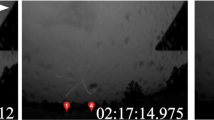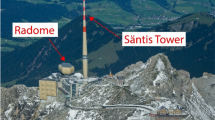Abstract
A narrowband radio interferometer has been developed and used to locate the entire sources of VHF radiations from a negative cloud-to-ground (CG) lightning discharge which contains 19 strokes. This system uses five antennas to form an array consisting of short-and long-baselines along two orthogonal directions. The system error which comes from frequency conversion is reduced by phase detection through direct high frequency amplifying. An interactive graphic analysis procedure is used to remove the fringe ambiguities which exist inherently in interferometry and to determine the direction of lightning radiation sources in two dimensions (azimuth and elevation) as a function of time at a time resolution of microsecond orders. With the developed system, the whole progression process in time and space of a lightning flash can be reconstructed. In this paper, combining the synchronous data of electric filed change and VHF radiation, the whole processes of an example negative CG flash have been studied in detail. It is found that the preliminary breakdown event of the CG flash started from negative charge region and exhibited firstly a downward pregression and then an upward propagation. There were very intense and continuous radiations during stepped leaders which became much stronger when the first return stroke began. In contrast, there were less and only discrete radiations during dart leaders. Stepped leader and dart leader may transform to each other depending on the state of the ionization of the path. The progression speed of initial stepped leaders was about 105 ms−1, while that was about 4.1×106 and 6.0×106 ms−1 for dart leaders and dart-stepped leaders, respectively. M events produced hook-shaped field changes accompanied by active burst of radiations at their beginnings. Followed these active radiation processes, M events appeared to contact finally into conducting main discharge channels. The mean progression speed of M events was about 7×107 ms−1, greater than that of the dart leaders and dart-step leaders. K events and attempted leaders were essentially the same as dart leaders except that they could not reach the ground and initiate return strokes.
Similar content being viewed by others
References
Rhodes C T, Shao X M, Krehbiel P R, et al. Observations of lightning phenomena using radio interferometry. J Geophys Res, 1994, 99(D6): 13059–13082
Dong W, Liu X, Zhang Y, et al. Observations on the leader-return stroke of cloud-to-ground lightning with broadband interferometer. Sci China Ser D-Earth Sci, 2002, 45(3): 259–269
Mazur V, Williams E, Boldi R, et al. Initial comparison of lightning mapping with operational Time-of-Arrival and Interferometric systems. J Geophys Res, 1997, 102(D10): 11071–11086
Shao X M. The development and structure of lightning discharges observed by VHF radio interferometer. Dissertation for the Doctoral Degree. Socorro: New Mexico Institute of Mining and Technology, 1993. 19–109
Dong W S, Liu X S, Qie X S, et al. Observation of VHF radiation from lightning. Prog Nat Sci (in Chinese), 2001, 11(9): 955–959
Shao X M, Holden D N, Rhodes C T. Broad band radio interferometry for lightning observations. Geophys Res Lett, 1996, 23(15): 1917–1920
Kawasaki Z, Mardiana R, Ushio T. Broadband and narrowband RF interferometers for lightning observations. Geophys Res Lett, 2000, 27(19): 3189–3192
Dong W S, Liu X S, Zhang Y J. Broadband interferometer observations of a triggered lightning. Chin Sci Bull, 2001, 46(18): 1561–1565
Krehbiel P R. An analysis of the electric field change produced by lightning. Dissertation for the Doctoral Degree. Manchester: University of Manchester Institute of Science and Technology, 1981. 31–102
Clarence N D, Malan D J. Preliminary discharge processes in lighting flashes to ground. Q J R Meteorol Soc, 1957, 83: 161–172
Kitagawa N, Brook M. A comparison of intracloud and cloud-to-ground lightning discharges. J Geophys Res, 1960, 65: 1189–1201
Shao X M, Krehbiel P R, Thomas R J, et al. Radio interferometric observations of cloud-to-ground lightning phenomena in Florida. J Geophys Res, 1995, 100(D2): 2749–2783
Author information
Authors and Affiliations
Corresponding author
Additional information
Supported by the Knowledge Innovation Program of the Chinese Academy of Sciences (Grant No. KZCX2-YW-206-2), the National Natural Science Foundation of China (Grant No. 40775004) and the National Science Fund for Distinguished Young Scholars (Grant No. 40325013)
Rights and permissions
About this article
Cite this article
Zhang, G., Zhao, Y., Qie, X. et al. Observation and study on the whole process of cloud-to-ground lightning using narrowband radio interferometer. Sci. China Ser. D-Earth Sci. 51, 694–708 (2008). https://doi.org/10.1007/s11430-008-0049-9
Received:
Accepted:
Published:
Issue Date:
DOI: https://doi.org/10.1007/s11430-008-0049-9




